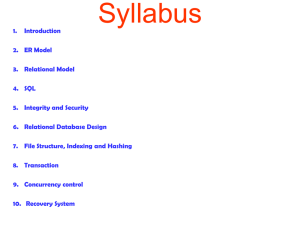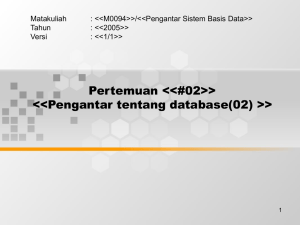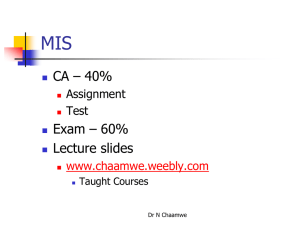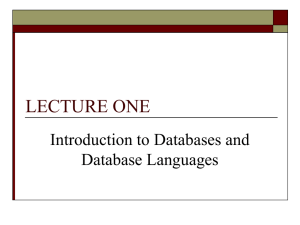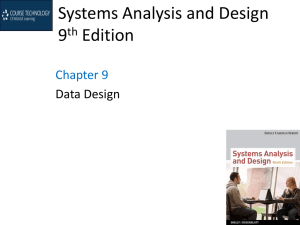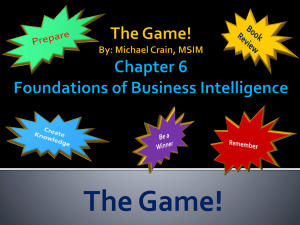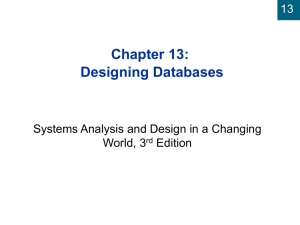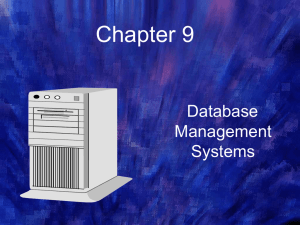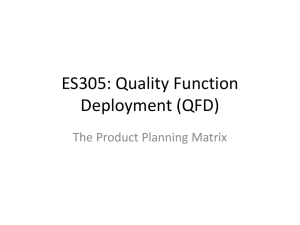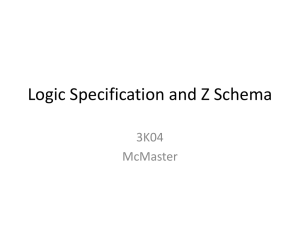Database Concepts
advertisement
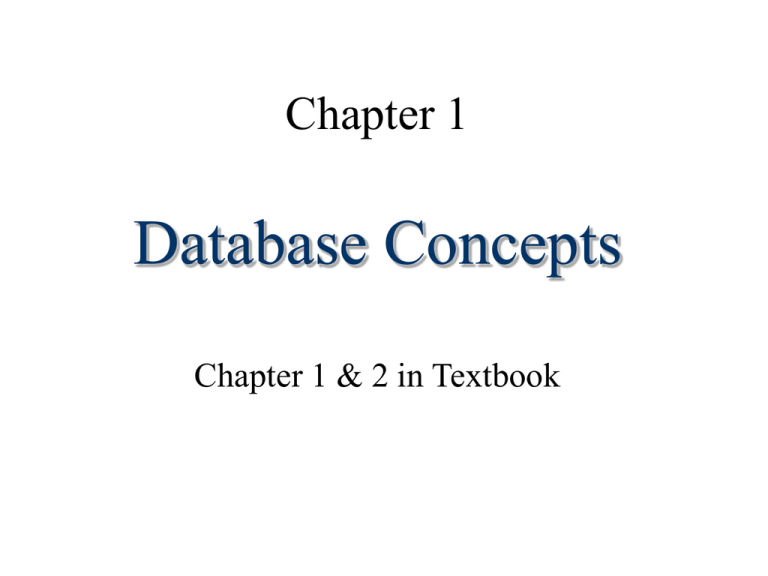
Chapter 1
Database Concepts
Chapter 1 & 2 in Textbook
Database Concepts
Data is a meaningless static value. e.g. Ali, 3421. What does 3421 means?
Information is the data you process in a manner that makes it meaningful.
Information can be provided only if proper data exists. e.g. “Ali ID number is
0987”.
A database (DB) is a collection of a logically related persistent data, designed to
meet the information needs of an organization. Can be generated & maintained
manually or automatically.
Data is what you store in database.
Information is what you retrieve from a database.
Database Concepts
2
Database Concepts
A database application is a collection of data and the programs that allow the
manipulation of these data to meet the information needs of an enterprise.
Database Management System (DBMS): A software system that facilitates the
creation and maintenance of a database, i.e. implementing database application.
Application Program (of a Database): a computer program that interacts with
database by issuing an appropriate request (SQL statement) to the DBMS.
Database System (DBS): is database and Software (DBMS + Application
Program).
Database Concepts
3
DBS Environment
Users/Programmers
DBS
Application Programs
DBMS
Query Process
Data Access
Meta-Data
Database Concepts
Database
4
Examples of Database Applications
• Edugate and ERegister.
• KSU Library.
• Supermarket system.
• Credit card system.
• Saudi Airlines Reservations.
Database Concepts
5
File-Based Systems (FBS)
FBS is a collection of application programs that perform tasks (e.g.
reports) where each program defines and manages its own data.
User 1 (Sales)
Data
Entry &
Reports
File
handling
File Def
Sales Application Program
User 2 (HR)
Data
Entry &
Reports
File
handling
File Def
HR Application Program
Database Concepts
Sales File
HR File
6
File-Based Systems (FBS)
Major limitations of FBS:
• Data Redundancy and Inconsistency.
• Data isolation and separation.
• Data dependence.
• Incompatible file formats.
• Fixed Queries/Proliferation of application programs.
Database Concepts
7
File-Based Systems (FBS)
These limitations of the FBS approach attributed to two factors:
• The definition of data is embedded in the application programs, rather
than being stored separately and independently.
• There is no control over the access & manipulation of data beyond the
imposed by the application program.
Database Concepts
8
Database Systems (DBS)
DBS is a single large repository of data, defined once and
managed using DBMS while used by many application programs.
DBS
User 1 (Sales)
Data
Entry &
Reports
Sales Application Program
DBMS
User 2 (HR)
Data
Entry &
Reports
Database
HR Application Program
Database Concepts
9
Database Systems (DBS)
Major characteristics of DBS:
• Self-describing nature of a database system.
• Program-data independence.
• Sharing of data and multi-user transactions processing
(guarantee Concurrency Control).
• Support of multiple views of the data.
Database Concepts
10
Database Systems (DBS)
Disadvantages of DBS:
• Complexity.
• Size.
• Cost (DBMS, Hardware, Staff, Training).
• Performance.
• Higher impact of a failure.
Database Concepts
11
Database Management System
(DBMS)
A DBMS is a collection of software that facilitates the
implementation and management of database applications.
DBMS facilitates the following:
•
Create and Define a DB.
•
Construct and Load a DB contents.
•
Manipulate a DB (query & update the DB).
•
Control access to data.
Database Concepts
12
Database Management System
(DBMS)
Major Relational DBMS vendors/products:
• Paradox/Corel.
• dBase/Clipper.
• FoxPro, Access & SQL Server/MS.
• MySQL.
• DB2/IBM.
• Oracle, Sybase, Informix.
Database Concepts
13
DBMS Languages
1. Data Definition Language (DDL):
– DDL is a descriptive language for defining and constructing the
database.
– Allows users to specify the data types and structures and the
constraints on the data to be stored in the DB.
– DDL compiler generates the meta-data that is stored in the data
dictionary.
Database Concepts
14
DBMS Languages
2. Data Manipulation Language (DML):
– DML is a language for retrieving and updating (insert, delete, &
modify) the data in the DB.
– Types of DML:
– Low level or Procedural Language: user specifies what data is
required and how to get those data.
– High level or Nonprocedural Language: user specifies what data is
required without specifying how to get those data.
Database Concepts
15
DBMS Languages
Both DDL and DML are usually not considered distinct
languages. Rather, they are included in a comprehensive
integrated language.
For example, SQL relational database language is a
comprehensive DB language which represents a combination of
DDL and DML.
Database Concepts
16
DBMS Languages
DBMS have a facility for embedding DDL & DML (sub-languages)
in a High-Level Language (COBOL, C, C++ or Java), which in
this case is considered a host language.
C,C++,Lisp,..
Application Program
Call to DB
DBMS
Local Vars
(memory)
Database Concepts
17
Roles in the Database Environment
Communicate
Procedure
User
Requirement
Write
DB Designer
Application
programmer
Use
App
Program
System Analyst
Design
Program
Write
DBA
Manage
DBMS
Naïve End User
DB
Use
Sophisticated End User
H/W
18
Roles in the Database Environment
System Analyst: Determine the user requirements and develop the
system specifications.
Database Designer: Identify the data and choose the appropriate
structure to represent and store the data.
Application Programmer: Implement the application program based
on the system specification.
Database administrator (DBA): Administrates the DB, DBMS and
related software.
Database Concepts
19
Roles in the Database Environment
Database End-users: They use the data for queries, reports and some
of them update the database content (data). End-users can be
categorized into:
– Naïve users: Invokes one of the permanent application programs that
have been written previously.
– Sophisticated users: form requests in a database query language.
Additional Roles:
– DBMS designer and implementer.
– Tool Developer.
– Operators and maintenance Personnel.
Database Concepts
20
Schemas versus Instances
Database Schema: The description of the database. It rarely changes.
– Includes descriptions of the database structure, data types, and the
constraints on the database.
Database Instance (snapshot): The actual data stored in a database at a
particular moment in time. Changes rapidly.
The concepts of Schema & Instances corresponds to Types & Values in
programming languages, respectively.
Database Concepts
21
Example
Schema
Database Concepts
Instance
22
Three-Schema Architecture
External
Level
Conceptual
Level
Internal
Level
User 1
User 2
View 1
View 2
User n
View n
Conceptual
Schema
Internal
Schema
DB
Database Concepts
23
Three-Schema Architecture
Defines DBMS schemas at three levels:
– External Level
• Describes that part of database that is relevant to a particular user.
• Users’ view of the database. The way perceived by end users.
– Conceptual Level
• Describes what data is stored in database and relationships among
the data.
• The way perceived by the DBA & programmers.
– Internal Level
• Describes how the data is stored in the database.
• The way perceived by the DBMS & OS.
Database Concepts
24
Three-Schema Architecture
External
Level
Staff_No
Conceptual
Level
Internal
Level
View 1
FName
Staff_No
View 2
LName
FName
Struct STAFF {
int Staff_No;
char FName [15];
char LName [15];
date DOB;
float Salary;
int Bno;
struct STAFF * next;
};
Age
Salary
LName
DOB
Staff_No LName
Salary
Bno
Bno
25
Three-Schema Architecture
Proposed to support DBMS characteristics of:
– Program-data independence.
– Support of multiple views of the data.
Database Concepts
26
Mapping
Mapping is the process of transforming requests and results
between the Internal, Conceptual & External levels.
• Programs refer to an external schema, and are mapped by the DBMS to
the internal schema for execution.
• Data extracted from the internal DBMS level is reformatted to match the
user’s external view.
Two types of mapping:
– External / Conceptual mapping.
– Conceptual / Internal mapping.
Database Concepts
27
Data Independence
Data Independence is the ability to modify a schema definition in
one level without affecting a schema definition in the next higher
level.
Two levels of data independence:
– Logical data independence.
– Physical data independence.
Data Independent is similar to the concept of ADT in programming
language where both hide the implementation details from the
user.
Database Concepts
28
Data Independence in Three-Schema
Architecture
External
Schema
External
Schema
External/Conceptual
Mapping
External
Schema
Logical data Independence
Conceptual
Schema
Conceptual/Internal
Mapping
Physical data Independence
Internal
Schema
Database Concepts
29
Data Models
Data Model: A set of concepts to describe the structure of a database, the
operations for manipulating these structures, and certain constraints that
the database should obey.
Purpose of data modelling is to represent data in an understandable way.
Categories of data models include:
– Conceptual data models (Object-based).
– Logical data models (Record-based).
– Physical data models.
Database Concepts
30
Categories of Data Models
Conceptual data models: is the construction of an enterprise’s
information that is independent of implementation details.
• Also called entity-based or object-based data models.
Logical data models: is the logical description of an
enterprise’s information with high level description of the
implementation.
• Also called record-based data models.
Physical data models: is the physical description of how data is
stored in the computer.
Database Concepts
31
Categories of Data Models
Hardware independent
Software independent
Conceptual
model
Hardware independent
Software dependent
Logical
model
Hardware dependent
Software dependent
Physical
model
Database Concepts
32
Data Models
Conceptual Data Models (Object-Based):
–
–
–
–
Entity-Relationship.
Semantic.
Functional.
Object-Oriented.
Logical Data Models (Record-Based):
– Relational Data Model.
– Network Data Model.
– Hierarchical Data Model.
Physical Data Models.
Database Concepts
33
Data Models
Staff
Branch
Staff_No LName
Relational
Data
Model
Network
Data
Model
Database Concepts
St1
St2
St3
St4
Name1
Name2
Name3
Name4
Salary Brn_No
7000
4000
6500
3000
1
1
2
3
Brn_No
Street Tel_No
1
2
3
Olayaa 4630000
Malaz 4780000
Rawda 2310000
St1
Name1
7000
Olayaa 4630000
St2
Name2
4000
Malaz 4780000
St3
Name3
6500
Rawda 2310000
St4
Name4
3000
34
Data Models
Malaz 4780000
St3
Name3
St1
Olayaa 4630000
St4
6500
Name1
Rawda 2310000
7000
St2
Name2
Name4
3000
4000
Hierarchical
Data Model
Database Concepts
35
Summary of DB Concepts
• Database (DB).
• Database Application.
• Database Management System (DBMS).
• Database System (DBS) - Centralized approach.
• File-Based System(FBS) - Decentralized approach.
• Program-data dependence & independence.
• Meta-data & data dictionary.
• Concurrency Control.
• Data Definition Language (DDL).
• Data Manipulation Language (DML).
Database Concepts
36
Summary of DB Concepts
• Schemas & Instances.
• Three-schema Architecture (internal, conceptual, external levels).
• Mapping (external/conceptual, conceptual/internal).
• Data Independence (logical & physical).
• Query language & host language.
• Conceptual model, Logical model, & Physical model.
• Data model (Entity-Relationship, Object-Oriented, Relational).
Database Concepts
37


